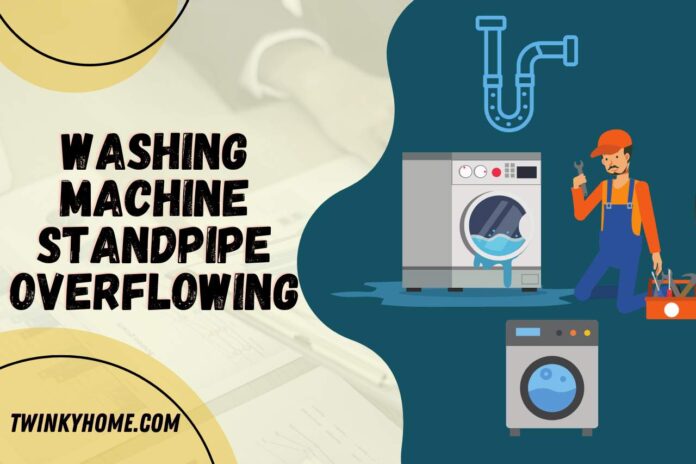Washing machine is an appliance that we often use in our everyday life. So it is terrible when a problem arises in the washing machine since the result will be a pile of dirty laundry. One of the problems that you might face is the washing machine standpipe overflowing. Today we have gathered a lot of information to give you a clear understanding of this issue. There are some reasons for this to happen, but you will know how to fix it preciously from this article.
Washing Machine Standpipe Overflowing
Let’s clarify what this issue is. The component that has been designed to drain the excess water is known as the washing machine standpipe. It is set to the washing machine on one end, and the other end removes the water away. Moreover, this pipe is responsible for handling the water that comes into the machine. Due to various issues, the standpipe might be overflowing and damaging the machine.
What happens is if the water stagnates in the standpipe for a while, a blockage can be formed inside. As a result, the water can overflow from the top of the pipe and flow down to the cabinets. Most of the time, this issue can be seen in small standpipes that are unable to handle the drainage systems. Since the core is small, the pipe can be clogged more easily than larger ones. No matter what the size of your washing machine, regular cleaning is the best practice to avoid these kinds of clogs.
This problem causes mould or mildew because of the mess that the pipe creates. If the leak is vast, there may be a worse condition than that. In case you cannot handle the leakage by yourself, you will need help from a professional as well.
What Causes the Washing Machine Standpipe to Overflow?
In brief, a blockage in the pipe, a difference in water pressure and a difference in water usage can cause the standpipe to overflow. Below are some major mistakes with more details.
- If the drain hose is 1¼” small, you will need a drain pipe at least one and a half diameter because the hose only drains the water, not the air. Thus, the drain pipe should facilitate the air to flow freely.
- The plumbing system has been equipped with a p-trap, which helps to block debris and any other waste. Therefore, it is really beneficial to keep the drainage system clear. But if it is absent or it is clogged by something, there will be overflowing water.
- The drain should avoid extending the p-trap arm, which is adjoined to the sink. Otherwise, the water will overflow in case it passes the last inches of the drain hose.
How to Tell If My Washing Machine Standpipe is Overflowing?
Before applying any remedy, you will have to diagnose the case with keen attention. Because sometimes there may be another issue with the drain, not the standpipe. Follow this simple trick to figure out the issue preciously.
- First, the drain hose should be removed from the pipe. You can simply use a knife or scissors to separate the zip tie.
- Secondly, you will need a garden hose to find out where the clog is. Stick it in the standpipe and turn it on. If the garden hose does not clog the wastewater, you can determine that the pump of the machine is not the culprit.
- Then take a flexible auger to put in the drain till it touches the resistance. If your hand feels something there, move the hand. Then take the auger out to see if there is any debris. If you could identify that this is the place where the issue exists, use a chemical drain cleaner and clean it. Or else, there are chemical packets that can be used with the liquid plunger.
- Finally, let the water flow into the standpipe. When you do it, the debris which blocks the pipe will be loosened.
How to Fix the Washing Machine Standpipe Overflowing?
Before trying to fix the standpipe, it would be better to go through the user manual of the washing machine because the method might vary from one model to the other. Most of the time, the user manual consists of the details to diagnose the issue as well.
In an immediate situation, follow these instructions to fix it by yourself. First of all, turn the washing machine off. Then apply the drain mode. If there is still water leaking, keep a bowl underneath the spout. After that, the lid can be opened to check whether the drainage has an issue.
After you fill the sink, you can measure the time it takes prior to draining. In case the drainage was done within approximate time, the clog cannot be a massive one. So, you can use an auger to break the clog. If not, the clog might be worse; you will need a big drain snake to unclog the pipe.
This could be followed as immediate action, but you will need to adhere to a long-term solution to prevent this from happening again. Thus, take a look at the next section.
How to Prevent the Standpipe from Overflowing?
In short, the main cause behind an overflowing standpipe is a blockage inside the pipe. So these methods will help to keep the pipe unclogged.
- To minimize unnecessary clogs, the best thing you can do is regular cleaning. The easiest method will be using a snake to put in the pipe and break any clogs. Make sure to pour some hot water after working with the snake because it will help to melt any gunk inside the pipe.
- A laundry sink can help you to keep the washing machine nice and clean. Moreover, if there are any wash materials that trap inside the pipe, the laundry sink will become a space for that unless you can use a mesh link catcher, which prevents the debris from going down into the pipe.
- Use some hot water along with baking soda if you do not have a snake for cleaning. Pour the hot water into the washing machine drain so it will kill bacteria and fungi as well. Pour clean cold water for the second time.
If this issue arises again and again, the best option would be to go for a replacement. High-efficiency washing machines use less water, but they are good at proper drainage than other machines.
Expand Your Horizons: More Content You Might Enjoy







![OGX Biotin And Collagen Shampoo Review [Updated One] Ogx Biotin And Collagen Shampoo Review](https://twinkyhome.com/wp-content/uploads/2022/03/Are-chicken-Super-Noodles-vegetarian-1-100x70.jpg)